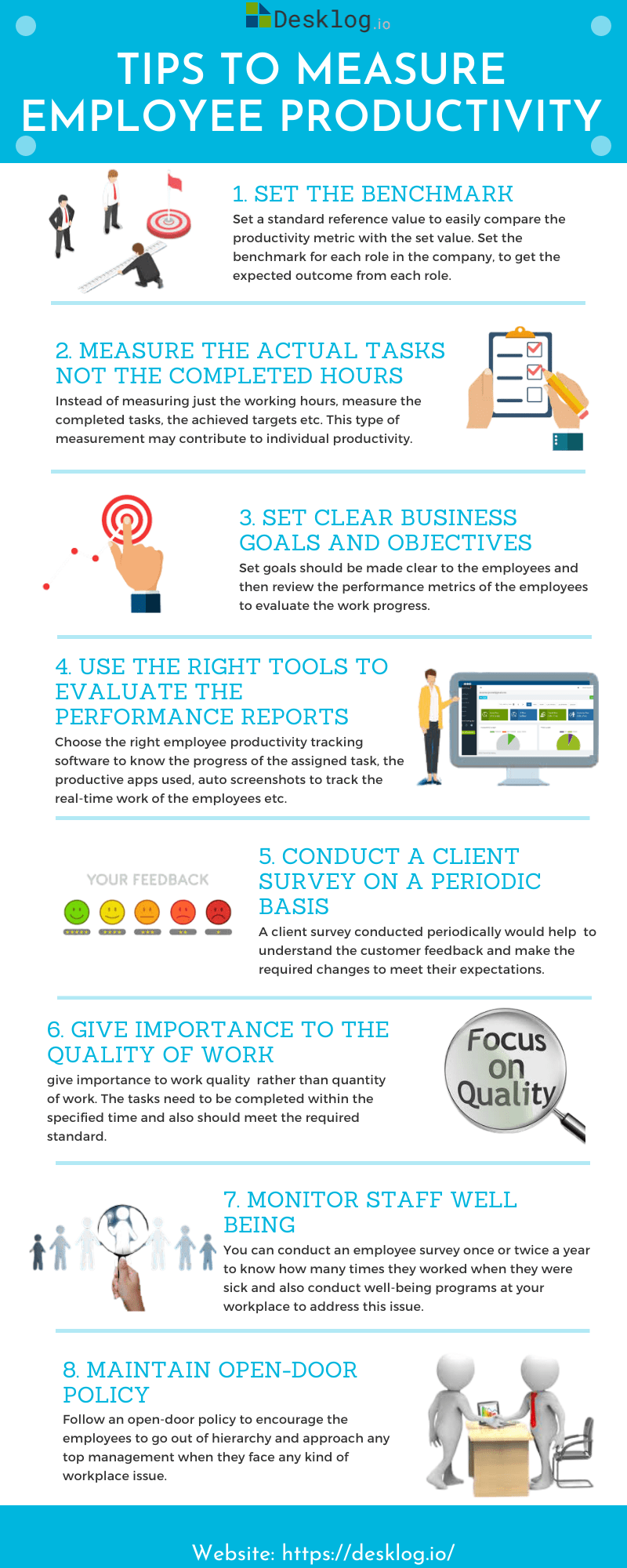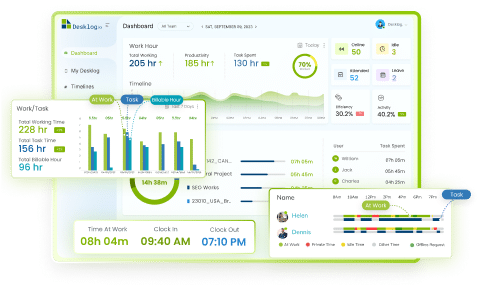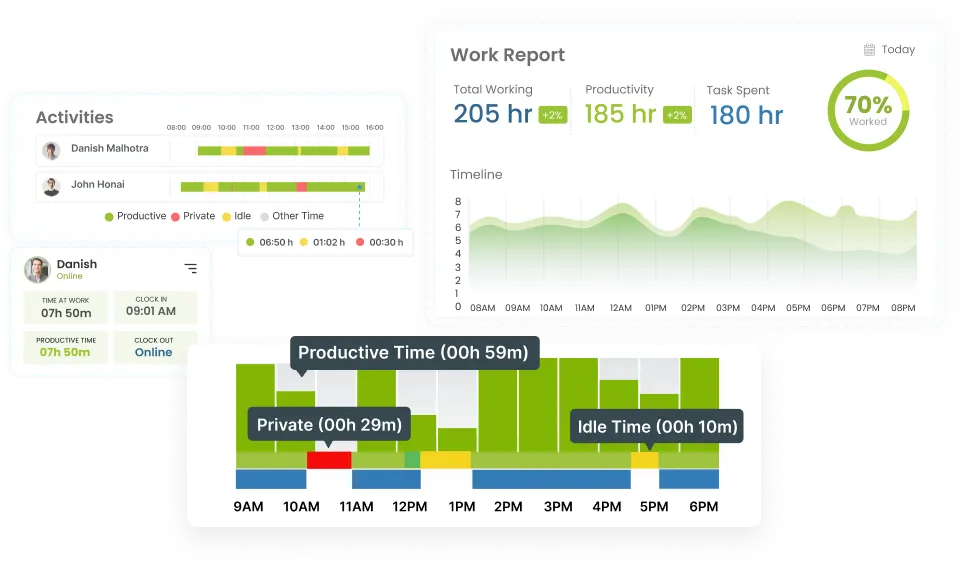
Tips To Measure Employee Productivity
To make your business more successful, you need to understand the importance of employee productivity monitoring software in your organization. Employees being productive assist the organization to enhance profitability, customer service, lower operational costs, and so on. As we all know that human capital is an asset of any workplace, we must know how to manage them effectively and make them utilize the resources efficiently to become more productive.
Now you may wonder how to measure employee productivity and know whether you are on the right track. Here we will see some tips to measure employee productivity and performance.
Before measuring productivity, you must know what employee productivity is?
What is Employee Productivity?
Employee productivity is a performance metric that is analyzed based on how efficiently the employees utilize their time to meet the business goals with the required quality.
This metric shows how the employees efficiently work on the assigned tasks to complete the work within the specified time. Overall this metric helps organizations to plan the resources required for the successful completion of projects.
Want to try our Time Tracking Software?
Try Desklog for free!

It is quite challenging to ensure productivity in the workplace so you must review these metrics frequently, So here are a few tips to measure employee productivity.
Know the Advantages of using an Employee Productivity Software
Tips for Measuring Employee Productivity
Measuring employee productivity and analyzing it would gain an insight into how skilled your employees are and how they are engaged in their work. Let’s have the look at tips
Let us look into the tips!

1. Set the Benchmark
Establish a standard reference value so that you can easily compare the productivity metric with that particular value. It is always better to set the benchmark for each role in the organization, this provides the expected outcome from each role. The expected productivity metric of each role is compared with the actual outcome of each role by assigning specific tasks to the roles.
This may not be very clear in some general roles like administrator, receptionist. However, you can set a certain benchmark for general roles too. It provides more clarity for both the employee and the employer. This benchmarking process could hold the employee more responsible for their work.
2. Measure the Actual Tasks not the Completed Hours
When the measurements are done, make sure it relates to the important functions of that role or job. For example, if you are measuring the productivity of the sales team, you can measure how effectively the support is offered to the customers, the number of sales made within the specified time, or how effectively they meet the sales target, and so on. This type of measurement may contribute to individual productivity. However, you can also measure the concerned group outcome.
Read the blog on How does Employee Time Tracking Software Work
3. Set Clear Business Goals and Objectives
Productivity is directly linked to the business goals of your organization. So whether it is short or long-term goals, you need to set exact and clear objectives. Your goals could be like increasing the company profit, getting into a new market, and finding a huge number of customers.
When employees can understand the link between productivity and their business goals, they could be more productive when compared to their competitors. So the set goals should be made clear to the employees and then review the performance metrics of the employees to evaluate work progress.
4. Use the Right Tools to Evaluate Performance Reports
As you need to frequently review the performance metrics or performance reports, it’s better to choose the right employee productivity tool to know how they work on their assigned task, on what type of productive apps they work, auto screenshots to track the real-time work of the employees. All these basic features of the tool provide an automated productivity report of the team or the individual, which saves your time in analyzing the performance reports.
Learn How to Choose the Right Employee Time Tracking Software
5. Conduct Client Surveys on a Periodic Basis
Customer is king and you must know how customers are treated by your employees. You must educate your employees to satisfy your customers and client surveys conducted periodically would help you to understand customer feedback and make the required changes to meet their expectations. This survey could also help you to get back to poorly performed individuals or teams and can also recognize the outstanding performance of the employees. This indirectly helps you to measure productivity.
6. Give Importance to the Quality of Work
In measuring productivity, you need to place a value for work quality than quantity of the work. The tasks need to be completed within the specified time and also should meet the required standard. This also should be the key performance indicator (KPI) of each role. By reviewing these KPIs and analyzing work quantity and the scheduled time, productivity can be effectively measured.
7. Monitor Staff Well Being
Keep track of staff well-being in your workplace. This affects employee productivity so tracking absenteeism and presenteeism of the employees is a key point while measuring productivity. If the employee performs well at work but takes sick leaves due to stress involved in work, it negatively impacts productivity. The other case is, though the employee is not doing well and he is present at work also impacts productivity during the long run. It is necessary to monitor both cases while measuring productivity. You can conduct an employee survey once or twice a year to know how many times they worked when they were sick and also conduct well-being programs at your workplace to address this issue.
Read more on Remote Work Management Software8. Maintain Open-door Policy
Organizational culture is something about what you and your employees should follow, do, or say at the workplace. How you treat your employees, client, or provide services will be a part of your culture. You may end up with so many different cultures followed by organizations like hierarchical, market, etc. It is always better to follow an open-door policy and this culture encourages the employees to go out of hierarchy and approach any top management when they face any kind of workplace issue. A poor culture will impact productivity as it makes the employees uncomfortable at the workplace. So set the culture and then set your company goals before measuring employee productivity.
9. Define Relevant Comparisons
An employee’s typical workday consists of various activities. Though the activities of different employees may differ, the works of those in the same department or working on similar tasks might be comparable. Comparing the performances of similar employees will help identify top contributors and those who are falling behind. This will also act as an internal motivator for employees to perform better.
10. Request Daily Updates
Employees would prefer to do their jobs and go about their business without someone micromanaging them. But that doesn’t always guarantee productivity. Many people may suffer from procrastination and this would compromise their output. But having to update someone at the end of the day could act as a motivator for such employees.
Conclusion
Measuring actual productivity is a complex process and the above tips will provide you an idea of the ways to measure employee productivity. Each employee should perform well to fulfill their set goals. And for that, you need to understand how they are engaged and make necessary changes to effectively measure employee productivity. Make use of an automated employee productivity tracking tool to measure productivity with automated reports.

















If you are looking,How to calculate the productivity of an employee? in this article, you will get the way to boost workplace productivity of employees.